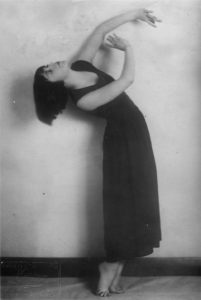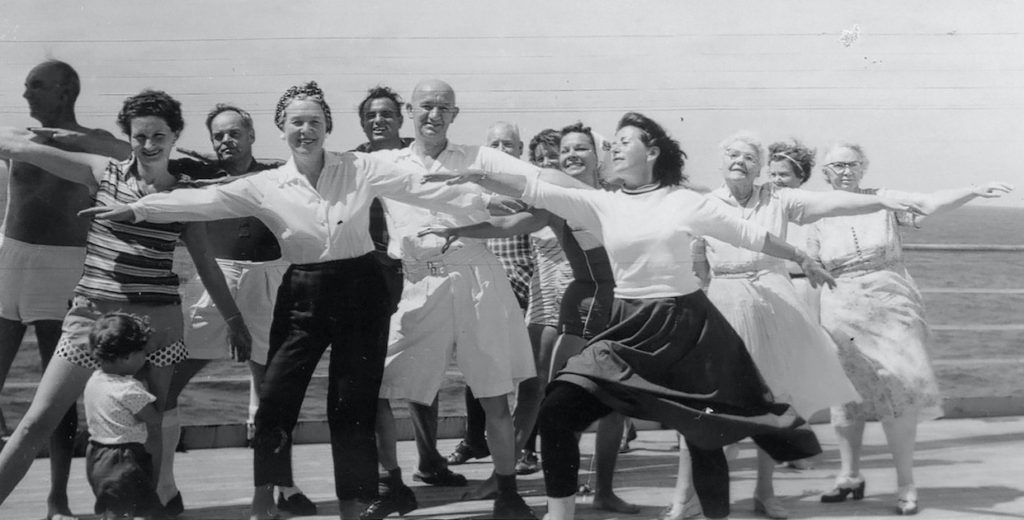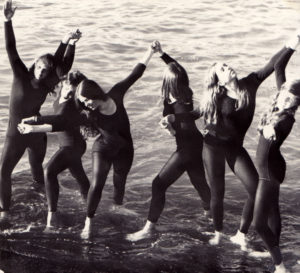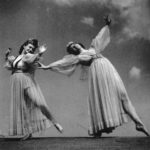Life Moves: The Hanovas contagious love of “the dance” - Vancouver Ballet Society
- Home
- Life Moves
- Life Moves: The Hanovas contagious love of “the dance”

By Karen Kurnaedy
Sisters Magda and Gertrud Hanova came to Vancouver in 1957 and opened the first modern dance school in the city. Although they were nearing 60, they energetically embraced Vancouver as a new horizon for their innovative blend of dance arts, which had grown out of their wide-ranging life experiences.

Born in pre-World War I Bohemia, the sisters were dancers in the 1920s when cultural life for artists of all kinds flourished in Europe. The sisters studied and performed ballet and modern dance in Vienna, Berlin, Paris, Dresden, and Karlsbad. In the early 1930s, they were forced to flee the Nazi persecution of Jewish people and settled in Bombay, India, where they taught and performed Dalcroze eurhythmics and European modern dance. They also studied yoga and Indian dance. A few years after World War Two ended, in the early 1950s, they studied in London, England, with modern dance innovators Rudolf Laban and Sigurd Leeder. And then they moved one more time, across the ocean to Vancouver, Canada.
At the Hanova Vancouver Dance School, where I trained at various times between the 1960s and 1990s, the sisters passionately instilled in their students notions of dance as a lifelong pursuit and a means to a healthy body, mind, and spirit. In every class, we were shown how to open ourselves to the Greek muse of the dance, Terpsichore, to experience dance as a physical, intellectual, and spiritual experience. The sisters did this through setting a tone of serious instruction, and by their conviction that in honouring the body with exercise and dance one was pursuing an art form of the highest kind. The sisters’ enthusiasm was contagious and we students were under their spell from the beginning until the end of each class, feeling that each movement we made brought us closer to fulfilling our capacity for self-expression, self-awareness, and creativity.

A typical class would begin with a Dalcroze warmup, which consisted of shaking each body part, and freely swinging and bending the limbs. Next, Gertrud would lead yoga exercises, which encouraged control of the body, flexibility, and balance. Magda then led a ballet barre for building strength, grace, and timing. A focus on Laban’s movement elements would follow, providing a structure and basis for the choreography and improvisation in the latter part of each class.

Hanova students ranged from young children to older adults, and, as the sisters grew older, their students aged along with them, many dancing into their 70s, 80s, and even 90s. Over their decades of teaching in Vancouver, the sisters created a unique community that drew students in search of that elusive something that can only be discovered in the experience of dancing.
The inspirational lessons at the Hanova studio continue to fuel the way I see the world, and how I appreciate the dance arts. In my 30 years as an elementary school teacher I infused movement and dance into many subject areas, leading students to appreciate their bodies as instruments for expression and healthy exercise. I also spent five years working with teachers at Simon Fraser University, sharing ideas for incorporating music and dance in the classroom. As a retiree, I continue to do yoga and see movement of all kinds, be it walking, dancing, or swimming, as a fundamental way to stay healthy. And I regularly attend dance performances of all kinds.
During the pandemic, I completed a book project, Our Love Affair with Dance. My aim was to preserve the treasure trove of material the sisters had left me that detailed their careers as dancers and dance teachers from the early 1900s into the late 1990s. The Hanova sisters’ letters, newspaper clippings, lecture demonstration notes, speeches, recorded interviews, and many beautiful photographs were shaped into a book that blends their histories and dance pedagogy, and my personal interpretation of who they were.
“The dance,” as Gertrud and Magda would say so reverentially, honours the body as a sacred site of knowing and expressing in the world. Discovering this early on in my classes with them has made all the difference to my own life.

